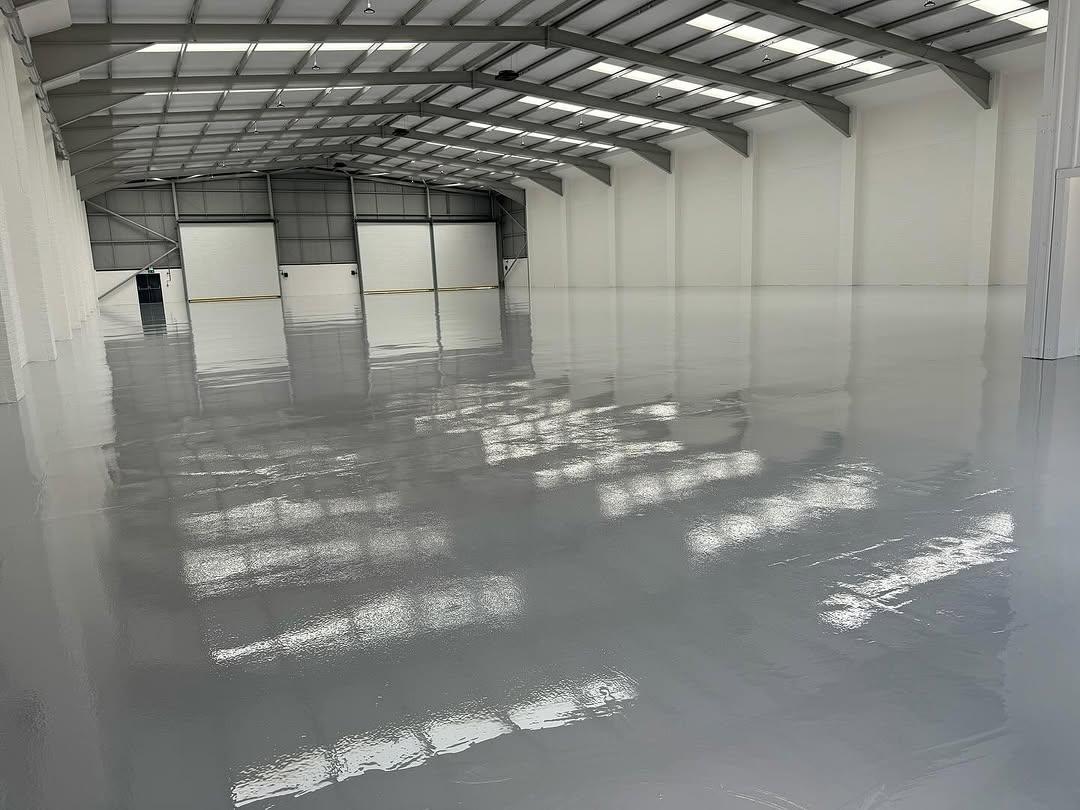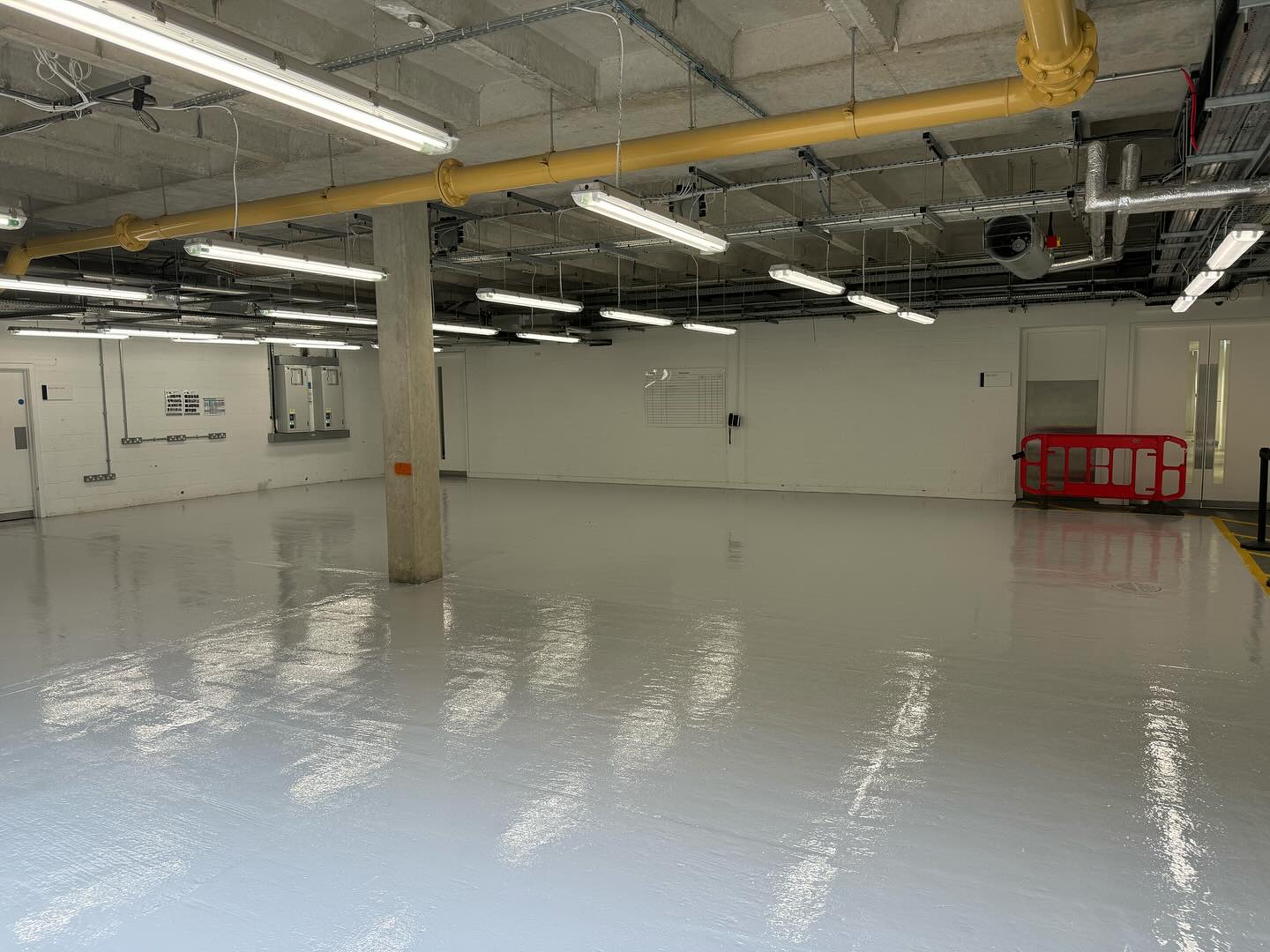Polyaspartic coatings cure in 2-4 hours with complete UV stability, making them ideal for areas with sunlight exposure at £11-15 per m². Traditional epoxy costs £11-15 per m² but yellows under UV light and requires 24-72 hours cure time. For internal warehouses without UV exposure, epoxy provides better value, while polyaspartic excels in loading bays and areas with natural light.
Polyaspartic technology represents the latest evolution in resin flooring systems, combining rapid cure times with UV stability that traditional epoxy can't match. However, this advanced chemistry comes at a premium that isn't always justified. After installing both systems across London facilities with varying UV exposure, we'll explain when polyaspartic's advantages warrant the investment.
The UV Yellowing Problem Solved
Standard epoxy turns amber or yellow when exposed to UV light, typically within 6-12 months of installation. This isn't just cosmetic - UV degradation causes chalking, where the surface becomes powdery and loses its protective properties. Areas near loading bay doors show distinct yellowing patterns where sunlight reaches.
Polyaspartic coatings contain aliphatic components that resist UV degradation indefinitely. We've inspected 10-year-old polyaspartic floors in south-facing loading bays that maintain their original colour. This UV stability makes polyaspartic essential for showrooms, retail spaces, and any area with windows or skylights.

Rapid Return to Service Reality
Polyaspartic's 2-4 hour cure time at 20°C allows same-day return to service. A 1000m² warehouse can be coated in the morning and operational by afternoon. This speed works at temperatures from -30°C to 140°C, making polyaspartic viable year-round without climate control.
However, this rapid cure creates application challenges similar to MMA systems. Once mixed, installers have 20-30 minutes before the material becomes unworkable. Any mistakes or delays result in visible defects that cannot be corrected. Only experienced crews achieve professional results with polyaspartic.
| Property | Epoxy | Polyaspartic |
|---|---|---|
| Pot Life | 30-45 minutes | 15-30 minutes |
| Tack Free | 8-10 hours | 1-2 hours |
| Foot Traffic | 24 hours | 2-4 hours |
| Full Traffic | 72 hours | 24 hours |
| Full Cure | 7 days | 24-48 hours |
Flexibility and Impact Absorption
Polyaspartic coatings offer 80-100% elongation compared to epoxy's 5-10%, providing rubber-like flexibility that handles substrate movement and thermal cycling. This flexibility prevents the stress cracking that plagues rigid epoxy in buildings with structural movement or external temperature exposure.
In multi-storey car parks, polyaspartic's flexibility accommodates deck movement from vehicle loads and temperature changes. The coating stretches rather than cracks, maintaining waterproofing integrity crucial for protecting steel reinforcement from corrosion.
Need UV-Stable Industrial Flooring?
Our experts determine whether polyaspartic's UV resistance and flexibility justify the premium for your specific environment.
Get Your UV AssessmentApplication Temperature Windows
Polyaspartic tolerates extreme application temperatures, curing properly from -30°C to 45°C with appropriate formulations. This eliminates seasonal installation restrictions and costly temporary heating. Surface moisture tolerance up to 12% allows application over damp concrete that would cause epoxy failure.
Standard epoxy requires 10-30°C application temperature and less than 4% substrate moisture. These restrictions often delay projects or require expensive environmental controls. In UK conditions, epoxy installation windows can be limited to April through October without heating.
Complete Cost Breakdown
| Cost Factor | Epoxy | Polyaspartic |
|---|---|---|
| Material per m² | £15-£11-15 per m² | £11-15 per m²-£11-15 per m² |
| Labour per m² | £5-£10 | £10-£15 |
| Total Installed | £11-15 per m²-£11-15 per m² | £11-15 per m²-£11-15 per m² |
| Downtime Saved | 3-5 days | Same day |
| UV Topcoat Option | +£8-12 | Included |
When adding UV-stable aliphatic polyurethane topcoats to epoxy for sun protection, the cost gap narrows to £11-15 per m². Contact us for a precise quote based on your specific project requirements. However, this two-coat system still requires extended cure times that polyaspartic avoids.
Colour Stability and Finish Options
Polyaspartic maintains colour consistency across batches better than epoxy, crucial for large areas requiring uniform appearance. The rapid cure prevents dust contamination that often mars epoxy surfaces in active facilities. Gloss retention exceeds 90% after 5 years, compared to epoxy's 60-70%.
Both systems offer similar decorative options including solid colours, flake broadcasts, and quartz systems. However, polyaspartic's clarity enhances decorative flakes and metallic pigments, creating more vibrant finishes particularly valuable in retail flooring and showrooms.

Long-Term Performance Differences
Epoxy's harder surface (Shore D 80-85) provides superior abrasion resistance for heavy forklift traffic, lasting 15-20 years in warehouses. The rigid structure handles compressive loads up to 70 N/mm² without indentation.
Polyaspartic's slightly softer surface (Shore D 75-80) shows wear faster under abrasive conditions but resists impact damage better. The flexibility prevents chipping from dropped tools or equipment. In moderate traffic areas, expect 12-18 years service life with polyaspartic.
Strategic Selection for Your Facility
Choose polyaspartic for:
- Areas with direct or indirect sunlight exposure
- External loading bays and transition zones
- Facilities requiring same-day return to service
- Cold storage installations without heating options
- Decorative floors in retail or showroom settings
- Multi-storey car parks with movement joints
Select epoxy when:
- Internal areas without UV exposure
- Heavy industrial traffic dominates
- Budget constraints exist
- Maximum abrasion resistance required
- Installation time allows proper curing
Consider hybrid solutions: epoxy base coats with polyaspartic topcoats combine epoxy's economical build thickness with polyaspartic's UV stability and rapid cure. This approach, common in modern warehouse flooring, optimises both performance and cost.
For more fast-cure options, explore our MMA comparison. For heavy-duty applications, see our guide on PU screed systems.
Specify the Right Coating System
Every facility has unique UV exposure and downtime constraints. We'll assess your requirements and recommend the optimal coating system.
Get Your Free Specification